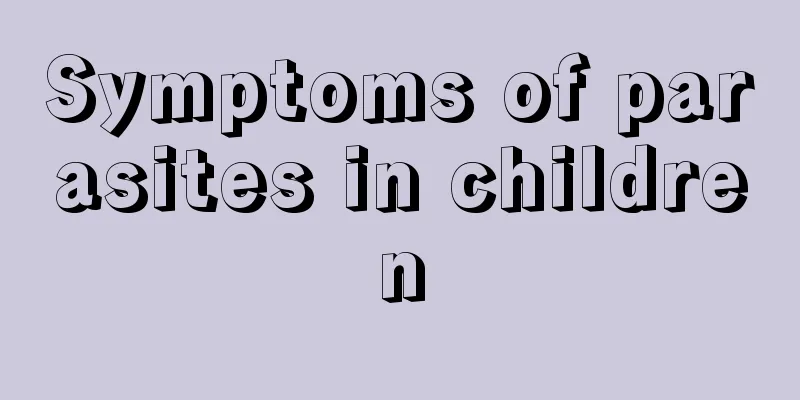Symptoms of parasites in children

|
Parasites are microorganisms that cannot be seen with the naked eye. They mainly obtain everything they need by living in the bodies of other organisms. There are many types of parasites. The most common ones are roundworms and whipworms. Roundworms mainly live in the intestines of organisms. Although these parasites may not necessarily cause lesions, they still have an impact on our bodies, such as making people lose weight. Do you know what symptoms a baby will have if he has parasites in his body? Symptoms of parasitic infection: 1. Hookworm Symptoms: weakness, abdominal pain, nausea, diarrhea, anemia. 2. Scabies Symptoms: itching, pain, pus, skin irritation. 3. Ascaris Symptoms: fever, fatigue, allergies, rash, vomiting, diarrhea, neurological problems, wheezing and coughing. 4. Schistosoma Symptoms: fever, pain, cough, diarrhea, swelling, lethargy. 5. Red worm Symptoms: Nausea, vomiting, inflammation of internal organs, diarrhea, weight loss, dizziness, cramps, malnutrition. 6. Pinworms Symptoms: Inflammation and itching. 7. Wuchereria bancrofti Symptoms: fever, chills, skin infection, lymph node pain, skin thickening and swelling. 8. Toxoplasma gondii Symptoms: Flu symptoms, fever, chills, weakness, headache. 9. Giardia lamblia Symptoms: Diarrhea, nausea, abdominal pain, weight loss, and burps that smell like rotten eggs. Parasitic diseases: 1. Malaria model The models of inoculating blood-borne gametocytes of Plasmodium berghei and Plasmodium yoelii into the peritoneal cavity of mice, or infecting rhesus monkeys with Plasmodium knowlesi are often used for screening antimalarial drugs. 2. Schistosomiasis japonicum model A variety of mammals can serve as terminal hosts. The cercariae are first obtained by the delivery method and then inoculated through the skin into rats, guinea pigs, rabbits, cats, dogs, etc. 3. Filariasis model China has successfully replicated three animal models: periodic Brugia malayi in long-clawed gerbils, interphase Brugia bancrofti in hamsters, domestic cats, monkeys, etc., and used mites to spread cotton rat filariasis in normal rat populations. How to determine if there are parasites in the body: 1. Ascariasis 1.1. Symptoms caused by larval migration: Ascaris eggs enter the lung bronchi and can cause symptoms such as cough, chest tightness, and bloody sputum. In severe cases, the virus may invade the brain, liver, spleen, thyroid gland and eyes, causing epilepsy, hepatomegaly and abdominal pain. 1.2. Symptoms caused by adult worms: loss of appetite or excessive eating and hunger, pica; frequent abdominal pain, mainly around the navel, and a preference for abdominal massage; some children may also become irritable, easily startled, or listless, and grind their teeth. In addition, foreign proteins in the insect body can cause allergic symptoms such as urticaria. Severe infection can cause malnutrition and affect growth and development. Children with mild roundworms may have no obvious symptoms. Severe cases may cause loss of appetite, or a preference for eating foreign objects, a sallow face and thin body, abdominal pain around the navel that comes and goes, a soft abdomen, or the worms may be felt. The child may also be vomiting roundworms or having roundworms in the stool, and the stool may be dry and watery. Some children have light white spots, blue spots on the sclera, granular white spots on the lower lip, thin and greasy or peeling tongue coating, and a red tip of the tongue. 2. Enterobiasis Pinworms, also known as nematodes, look like a white line and are about 2 cm (half an inch) long. They live in the large intestine of children and are sometimes excreted in the feces of children. Countless white worms can be seen wriggling in the feces. These are pinworms. Adult pinworms parasitize the human cecum, appendix, colon, rectum and lower ileum. When a person falls asleep and the anal sphincter relaxes, some female insects crawl out of the anus and lay eggs on the nearby skin. After laying eggs, most female worms die of desiccation, but a few can migrate back to the intestinal cavity through the anus. If it enters the vagina, uterus, fallopian tube, urethra, abdominal cavity, pelvic cavity and other parts, it may cause ectopic parasitism. The most common symptoms of pinworm infection are anal itching and restless eye blinking. Local skin may develop dermatitis and secondary infection due to itching. Systemic symptoms include gastrointestinal irritation, such as nausea, vomiting, abdominal pain, diarrhea, loss of appetite, as well as restlessness, night terrors, irritability and other mental symptoms. 3. Hookworm disease Hookworm is a general term for nematodes of the family Ancylostoma, and the well-developed oral sac is its morphological characteristic. Among the nematodes that parasitize the human digestive tract, hookworms are the most harmful. Due to the parasitism of hookworms, the human body can suffer from long-term chronic blood loss, leading to anemia and anemia-related symptoms in patients. Hookworms are distributed worldwide, especially in tropical and subtropical regions, where infection is more common among people. It is estimated that there are about 900 million people infected with hookworms worldwide. In my country, hookworm disease is still one of the parasitic diseases that seriously endangers people's health. Hookworm infection can cause dermatitis, and punctate papules or small blisters may appear on the thin skin between the toes or fingers and on other exposed skin. Hookworm disease can also cause respiratory symptoms such as cough, bloody sputum, fever, shortness of breath and asthma, blood in the sputum, and even severe hemoptysis. It manifests as varying degrees of anemia, pale skin and mucous membranes, fatigue, and dizziness, which affect the physical and intellectual development of children. In severe cases, anemic heart disease may occur. The initial manifestations of digestive tract symptoms are bulimia, eating a lot and feeling hungry easily, but also weight loss. In the later stage, there will be decreased appetite, abdominal distension, pica, malnutrition, etc. In severe cases, blood in the stool may occur. 4. Red worm disease The red threadworm is a giant intestinal parasite that can reach a length of 72 feet. A class of the phylum Platyhelminthes. All of them lead a parasitic life. Adults parasitize vertebrates, while larvae mainly parasitize invertebrates or use vertebrates as intermediate hosts. Half of the patients have abdominal pain, usually dull pain in the upper abdomen or the entire abdomen. A few patients have diarrhea. Symptoms include increased appetite, dizziness, etc. |
<<: Symptoms of stomatitis in babies
>>: Symptoms of pancreatitis in children
Recommend
Is it normal for children to change their teeth at the age of five and a half?
Tooth replacement is an experience that every chi...
Why does my baby suddenly cry at night?
Babies are the flowers of the motherland. People ...
Will children have fever when they grow up?
In fact, children will not have a fever when they...
What are the effects of general anesthesia on children?
If a child needs to undergo general anesthesia, p...
What to do if your child vomits repeatedly
For children, the intestines are very sensitive. ...
Causes of Teeth Grinding in Teenagers
When teenagers grind their teeth, many people can...
Is massage effective for children with anorexia?
If parents spoil their children for a long time o...
What kind of milk powder should babies eat for autumn diarrhea
Autumn is relatively dry and many people don’t li...
What should I do if my child has asthma?
Asthma is a very common respiratory disease. Many...
What Chinese medicine should babies take when they have internal heat?
The baby's immunity is relatively weak, espec...
Will children with roseola become sleepy?
Roseola is a common problem in children, but we a...
What are the main symptoms of ADHD in children?
Nowadays, children do not have a certain awarenes...
What should children eat when they have nosebleeds?
Children are more naughty, and sometimes there wi...
What to do if your child has thrush? Tell you effective measures!
Some infants and young children have obvious maln...
How is pink eye transmitted?
Conjunctivitis is a contagious eye disease, and t...









